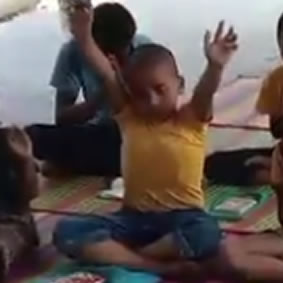Transforming Bangladesh Villages with Gita Classes: Remarkable Changes
- David Burgess
- 3 days ago
- 8 min read
Key Takeaways
Gita classes are transforming villages in Bangladesh by fostering spiritual growth and community cohesion.
Introducing Gita classes involves engaging local leaders and tailoring the curriculum to meet community needs.
Classes are structured to encourage active participation and reflection, leading to improved social behaviors.
Local leaders play a crucial role in promoting and sustaining these classes in their communities.
Despite challenges, the long-term benefits of Gita classes include enhanced social harmony and personal development.
A Bhagavad Gita Class In A Rural Bangladeshi Village
The Power of Gita Classes
The Bhagavad Gita, a revered spiritual text, offers timeless wisdom that can transform lives. Its teachings on duty, righteousness, and self-realization resonate deeply with individuals seeking personal and communal growth. In Bangladesh, Gita classes have become a guiding star, pointing villagers towards a more harmonious and spiritually enriched life.
Spiritual Education Needs in Rural Bangladesh
In many rural areas of Bangladesh, access to formal spiritual education is limited. Villagers often rely on traditional practices and oral traditions to pass down spiritual knowledge.
However, these methods may not fully address contemporary challenges. Therefore, there is a pressing need for structured spiritual education that can provide practical guidance for daily life.
Introducing Gita Classes to Villages
Bringing Gita classes to villages requires a thoughtful approach. It's not just about reading the text; it's about making the teachings relevant and applicable to the villagers' lives. This involves understanding their specific needs and challenges and crafting a curriculum that speaks directly to them.
Community Partnership and Engagement
To successfully introduce Gita classes, building strong community partnerships is essential. Engaging with local leaders and gaining their support can significantly enhance the program's acceptance and sustainability. These leaders act as bridges, connecting the teachings of the Gita with the cultural and social fabric of the community.
“When we started Gita classes in our village, it was the local elders who helped spread the word and encourage participation. Their endorsement made all the difference.”
Besides that, involving community members in the planning and execution of classes fosters a sense of ownership and commitment. This collaborative approach ensures that the classes are not seen as an external imposition but as an integral part of community life.
Class Structure and Curriculum
The structure of Gita classes is crucial for engaging participants and facilitating meaningful learning. Classes are typically divided into sections that include reading, discussion, and reflection. This format encourages active participation and allows villagers to connect the teachings to their personal experiences.
Most importantly, the curriculum should be adaptable to the specific cultural context of each village. This means using local languages and examples that resonate with the participants' daily lives. By doing so, the teachings of the Gita become more accessible and relatable, fostering deeper understanding and application.
Role of Local Leaders and Teachers
Local leaders and teachers play a pivotal role in the success of Gita classes. They serve as facilitators, guiding discussions and helping participants explore the deeper meanings of the text. Their familiarity with the community allows them to tailor the teachings to address specific issues and concerns.
Furthermore, these leaders often become role models, embodying the principles of the Gita in their own lives. Their example inspires others to follow suit, creating a ripple effect of positive change throughout the village.
Rise in Community Involvement and Participation
One of the most remarkable outcomes of introducing Gita classes in villages is the noticeable rise in community involvement and participation. As villagers gather regularly for these classes, a sense of unity and shared purpose emerges. This collective engagement fosters a stronger community bond, encouraging individuals to participate more actively in other communal activities and initiatives.
What's more, these classes often become a platform for discussing broader community issues, leading to collaborative problem-solving efforts. Villagers who might have been passive observers before now take on more proactive roles, contributing to the community's overall well-being.
Impact on Individual Behavior and Outlook
Gita classes have a profound impact on individual behavior and outlook. Participants often report a greater sense of inner peace and clarity after engaging with the teachings. The principles of duty, self-discipline, and self-awareness highlighted in the Gita encourage individuals to reflect on their actions and make more conscious choices.
This transformation is evident in the way villagers approach their daily tasks and interactions. Many find themselves more patient, empathetic, and resilient in the face of challenges. This shift in mindset not only benefits the individuals but also positively influences the community as a whole. For further insights on these changes, consider exploring everyday lessons from the Bhagavad Gita.
Challenges and Solutions

Students Overcome Obstacles To Attend Gita Class
Despite the positive changes, introducing Gita classes in villages is not without challenges. Understanding these obstacles and devising effective solutions is crucial for the long-term success of the program.
Overcoming Initial Resistance
Initially, some villagers may resist the idea of attending Gita classes, viewing them as irrelevant or time-consuming. To overcome this resistance, it's important to communicate the tangible benefits of the classes clearly.
Engaging local influencers and respected community members to advocate for the classes can also help build trust and interest. Sharing success stories and testimonials from those who have experienced positive changes can further motivate hesitant individuals to participate.
Ensuring Consistent Participation
Schedule classes at convenient times for participants, considering their daily routines.
Provide incentives such as refreshments or certificates of participation to encourage attendance.
Create a welcoming and inclusive environment where everyone feels valued and heard.
Consistency in attendance is vital for the effectiveness of Gita classes. By implementing strategies that address logistical and motivational barriers, we can ensure that participants remain engaged over the long term.
Another strategy is to integrate Gita teachings with other community activities, making them a natural part of the villagers' lives. For example, incorporating Gita readings into existing cultural or religious gatherings can increase exposure and participation.
Regular feedback sessions can also help identify any issues or concerns participants may have, allowing facilitators to make necessary adjustments to improve the experience. For those interested in deeper spiritual insights, consider exploring everyday lessons from the Bhagavad Gita.
Long-term Sustainability Strategies
For Gita classes to have a lasting impact, sustainability must be a key focus. This involves not only maintaining participant interest but also ensuring that the program can continue independently over time.
One approach is to train local teachers and facilitators who can carry on the work even if external support is withdrawn. Providing these individuals with ongoing training and resources ensures that they are well-equipped to lead the classes effectively.
Additionally, establishing a network of villages participating in Gita classes can foster collaboration and resource-sharing, strengthening the program's overall resilience.
Future Prospects for Expanding Gita Classes
Looking ahead, there is significant potential for expanding Gita classes to more villages across Bangladesh. The success stories from initial implementations serve as powerful testimonials, encouraging other communities to adopt similar initiatives.
Potential for National Adoption
With the right support and resources, Gita classes could become a nationwide movement. By demonstrating the positive impacts on community cohesion and individual well-being, we can advocate for broader adoption at the national level.
Partnering with governmental and non-governmental organizations can provide the necessary infrastructure and funding to scale up the program, reaching more rural areas across the country.
Creating a Network for Support and Resources
Establishing a robust support network is crucial for the sustained success of Gita classes. This network can connect facilitators, participants, and supporters, enabling the exchange of ideas, resources, and best practices.
Regular workshops and conferences can bring together stakeholders from different regions, fostering collaboration and innovation. By sharing successes and challenges, we can collectively enhance the program's effectiveness and reach.
Ultimately, the goal is to create a self-sustaining ecosystem that nurtures spiritual growth and community development across Bangladesh.
Final Thoughts on the Impact of Gita Classes

Students' Lives Are Changed After Attending Bhagavad Gita Class
Gita classes have proven to be a transformative force in rural Bangladesh, offering profound spiritual insights and practical guidance for everyday life. By fostering a deeper understanding of self and community, these classes contribute to personal growth and social harmony. The impact is not just limited to individual enlightenment; it extends to the entire community, creating a more cohesive and supportive environment for all.
Summary of Key Changes
The introduction of Gita classes has led to several positive changes in the villages. Social cohesion has improved, with villagers coming together more frequently and engaging in meaningful dialogue. Individual behaviors have shifted towards greater empathy, patience, and resilience. Moreover, the classes have inspired a rise in community involvement, with more people participating in local initiatives and activities.
Encouragement for Other Communities to Adopt
Seeing the success of Gita classes in these villages, other communities are encouraged to adopt similar programs. The benefits are clear and far-reaching, affecting both personal development and community well-being. By embracing the teachings of the Gita, villages can cultivate a culture of understanding, cooperation, and spiritual growth. It is a step towards creating a more harmonious and enlightened society.
Frequently Asked Questions (FAQ)
Here are some common questions about Gita classes and their impact on rural communities:
What is the main goal of Gita classes in villages?
The primary goal of Gita classes in villages is to provide spiritual education that enhances personal and community development. These classes aim to impart the teachings of the Bhagavad Gita in a way that is relevant and accessible, encouraging individuals to lead more conscious and purposeful lives.
How do Gita classes address social issues in villages?
Gita classes address social issues by promoting values such as empathy, patience, and cooperation. These teachings encourage individuals to reflect on their actions and interactions, leading to more harmonious relationships within the community.
By fostering open dialogue and understanding, Gita classes also help resolve conflicts and build a stronger sense of unity among villagers.
Are these classes accessible to everyone in the village?
Yes, Gita classes are designed to be inclusive and accessible to all members of the village, regardless of age, gender, or social status. Efforts are made to accommodate different schedules and provide resources in local languages to ensure broad participation.
Additionally, classes are often held in communal spaces that are easily accessible, further encouraging attendance.
Classes are scheduled at convenient times to fit villagers' routines.
Local languages are used to ensure understanding and engagement.
Efforts are made to create a welcoming and inclusive environment.
Overall, the goal is to make spiritual education a shared and accessible experience for the entire community.
What challenges do facilitators face in organizing these classes?
Facilitators may encounter challenges such as initial resistance from villagers, logistical issues related to scheduling and location, and ensuring consistent attendance. Building trust and demonstrating the value of the classes can help overcome these obstacles.
Additionally, facilitators need to continuously adapt the curriculum to meet the evolving needs of the community, which requires ongoing engagement and feedback.
By fostering strong community partnerships and providing incentives for participation, facilitators can effectively address these challenges and ensure the success of the program.
What is the long-term vision for Gita classes in rural Bangladesh?
The long-term vision for Gita classes in rural Bangladesh is to create a self-sustaining network of spiritually enriched communities. This involves training local leaders and facilitators who can independently carry on the teachings, ensuring continuity and growth.
Expanding the reach of Gita classes to more villages and integrating modern technology for wider accessibility are also part of the vision. Ultimately, the goal is to foster a culture of spiritual growth and community cohesion that transcends geographical and cultural boundaries.









Comentários